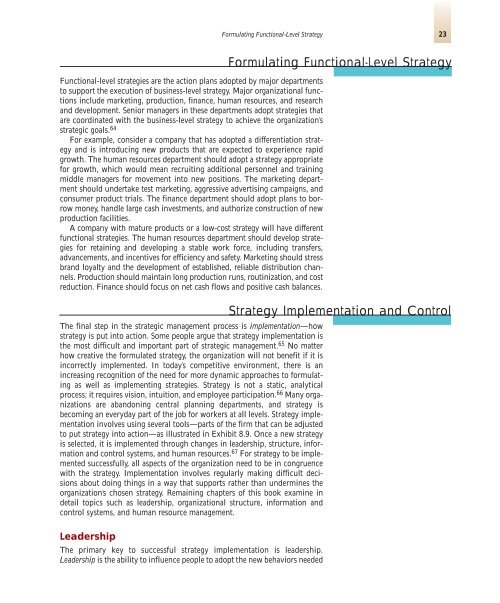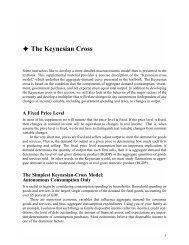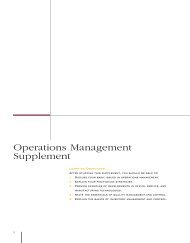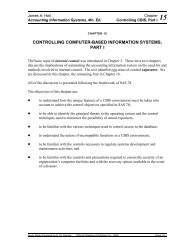chapter 8: strategy formulation and implementation
chapter 8: strategy formulation and implementation
chapter 8: strategy formulation and implementation
You also want an ePaper? Increase the reach of your titles
YUMPU automatically turns print PDFs into web optimized ePapers that Google loves.
Functional-level strategies are the action plans adopted by major departments<br />
to support the execution of business-level <strong>strategy</strong>. Major organizational functions<br />
include marketing, production, finance, human resources, <strong>and</strong> research<br />
<strong>and</strong> development. Senior managers in these departments adopt strategies that<br />
are coordinated with the business-level <strong>strategy</strong> to achieve the organization’s<br />
strategic goals. 64<br />
For example, consider a company that has adopted a differentiation <strong>strategy</strong><br />
<strong>and</strong> is introducing new products that are expected to experience rapid<br />
growth. The human resources department should adopt a <strong>strategy</strong> appropriate<br />
for growth, which would mean recruiting additional personnel <strong>and</strong> training<br />
middle managers for movement into new positions. The marketing department<br />
should undertake test marketing, aggressive advertising campaigns, <strong>and</strong><br />
consumer product trials. The finance department should adopt plans to borrow<br />
money, h<strong>and</strong>le large cash investments, <strong>and</strong> authorize construction of new<br />
production facilities.<br />
A company with mature products or a low-cost <strong>strategy</strong> will have different<br />
functional strategies. The human resources department should develop strategies<br />
for retaining <strong>and</strong> developing a stable work force, including transfers,<br />
advancements, <strong>and</strong> incentives for efficiency <strong>and</strong> safety. Marketing should stress<br />
br<strong>and</strong> loyalty <strong>and</strong> the development of established, reliable distribution channels.<br />
Production should maintain long production runs, routinization, <strong>and</strong> cost<br />
reduction. Finance should focus on net cash flows <strong>and</strong> positive cash balances.<br />
The final step in the strategic management process is <strong>implementation</strong>—how<br />
<strong>strategy</strong> is put into action. Some people argue that <strong>strategy</strong> <strong>implementation</strong> is<br />
the most difficult <strong>and</strong> important part of strategic management. 65 No matter<br />
how creative the formulated <strong>strategy</strong>, the organization will not benefit if it is<br />
incorrectly implemented. In today’s competitive environment, there is an<br />
increasing recognition of the need for more dynamic approaches to formulating<br />
as well as implementing strategies. Strategy is not a static, analytical<br />
process; it requires vision, intuition, <strong>and</strong> employee participation. 66 Many organizations<br />
are ab<strong>and</strong>oning central planning departments, <strong>and</strong> <strong>strategy</strong> is<br />
becoming an everyday part of the job for workers at all levels. Strategy <strong>implementation</strong><br />
involves using several tools—parts of the firm that can be adjusted<br />
to put <strong>strategy</strong> into action—as illustrated in Exhibit 8.9. Once a new <strong>strategy</strong><br />
is selected, it is implemented through changes in leadership, structure, information<br />
<strong>and</strong> control systems, <strong>and</strong> human resources. 67 For <strong>strategy</strong> to be implemented<br />
successfully, all aspects of the organization need to be in congruence<br />
with the <strong>strategy</strong>. Implementation involves regularly making difficult decisions<br />
about doing things in a way that supports rather than undermines the<br />
organization’s chosen <strong>strategy</strong>. Remaining <strong>chapter</strong>s of this book examine in<br />
detail topics such as leadership, organizational structure, information <strong>and</strong><br />
control systems, <strong>and</strong> human resource management.<br />
Leadership<br />
The primary key to successful <strong>strategy</strong> <strong>implementation</strong> is leadership.<br />
Leadership is the ability to influence people to adopt the new behaviors needed<br />
Formulating Functional-Level Strategy 23<br />
Formulating Functional-Level Strategy<br />
Strategy Implementation <strong>and</strong> Control










